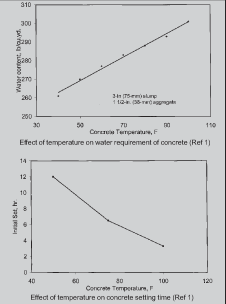Information from the National Ready Mixed Concrete Association
WHAT is Hot Weather?

Effects of temperature on concrete setting time
Hot weather may be defined as any period of high temperature in which special precautions need to be taken to ensure proper handling, placing, finishing and curing of concrete. Hot weather problems are most frequently encountered in the summer, but the associated climatic factors of high winds, low relative humidity and solar radiation can occur at any time, especially in arid or tropical climates. Hot weather conditions can produce a rapid rate of evaporation of moisture from the surface of the concrete and accelerated setting time, among other problems. Generally, high relative humidity tends to reduce the effects of high temperature.
WHY Consider Hot Weather?
It is important that hot weather be taken into account when planning concrete projects because of the potential effects on fresh and recently placed concrete. High temperatures alone cause increased water demand, which, in turn, will raise the water-cement ratio and result in lower potential strength. Higher temperatures tend to accelerate slump loss and can cause loss of entrained air. Temperature also has a major effect on the setting time of concrete: concrete placed under high temperatures will set quicker and can, therefore, require more rapid finishing. Concrete that is cured at high temperatures at an early age will not be as strong at 28 days as the same concrete cured at temperatures in the range of 70°F (20°C).
High temperatures, high wind velocity, and low relative humidity can affect fresh concrete in two important ways: the high rate of evaporation may induce early plastic shrinkage or drying shrinkage cracking, and the evaporation rate can remove surface water necessary for hydration unless proper curing methods are employed. Thermal cracking may result from rapid drops in the temperature of the concrete, such as when concrete stabs or walls are placed on a hot day followed by a cool night. High temperature also accelerates cement hydration and contributes to the potential for thermal cracking in massive concrete structures.
HOW to Concrete in Hot Weather?
The key to successful hot weather concreting is:
- Recognition of the factors that affect concrete; and
- planning to minimize their effects
Use proven local recommendations for adjusting concrete proportions, such as the use of water reducing and set retarding admixtures. Modifying the mixture to reduce the heat generated by cement hydration, such as the use of an ASTM Type II moderate heat cement and the use of pozzolans and slag can reduce potential problems with high concrete temperature. Advance Effect of temperature on water requirement of concrete (Ref 1) Effect of temperature on concrete setting time (Ref 1) lowed by a cool night. High temperature also accelerates cement hydration and contributes to the potential for thermal cracking in massive concrete structures. 1982, 1989 AND 2000 timing and scheduling to avoid delays in delivery, placing and finishing is essential. Trucks should be able to discharge immediately and adequate personnel should be available to place and handle the concrete. When possible, deliveries should be scheduled to avoid the hottest part of the day. Limits on maximum concrete temperature may be waived by the purchaser if the concrete consistency is adequate for the placement and excessive water addition is not required.
In the case of extreme temperature conditions or with mass concrete, the concrete temperature can be lowered by using chilled water or ice as part of the mixing water. The ready mixed concrete producer uses other measures, such as sprinkling and shading the aggregate prior to mixing, to help lower the temperature of the concrete.
If low humidity and high winds are predicted, windbreaks, sunscreens, mist fogging, or evaporation retardants may be needed.
References
- Hot Weather Concreting, ACI 305R, American Concrete Institute, Farmington Hills, MI.
- Cooling Ready Mixed Concrete, NRMCA Publication No. 106, NRMCA, Silver Spring, MD.
- Effect of Temperature and Delivery Time on Concrete Proportions, R.D. Gaynor, R.C. Meininger, T.S. Khan, NRMCA Publication 171, NRMCA, Silver Spring, MD.
- Hot-Weather Concreting, Chapter 11 in Design and Control of Concrete Mixtures, Portland Cement Association, Skokie, IL.
- Keeping Concrete Cool in the Heat of Summer, K.C. Hover, Concrete Construction, June 199
USED WITH PERMISSION FROM THE NRMCA
